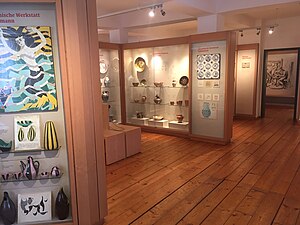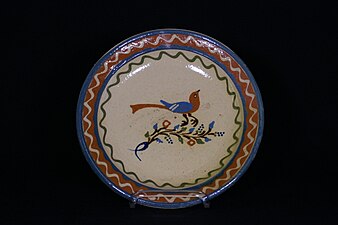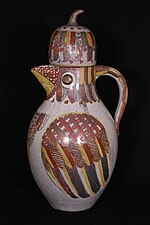Pottery Museum Thurnau
The Thurnau Pottery Museum in the market town of Thurnau is a special museum for pottery made in Thurnau . Working methods, vessel shapes and decoration techniques of the Thurnau pottery are presented on an exhibition area of around 600 m².
Thurnau pottery
Hafner has been proven in Thurnau since 1579. From the second half of the 18th century, the number of potters working simultaneously increased. In 1800 four potters worked on site. In 1870 the upward trend reached its peak with eight workshops.
Mainly utensils were produced: simple pottery for the kitchen, stable and field. Initially glazed in one color, from the 19th century also decorated with the Malhorn . In addition to pots, pots, pans, jugs, bowls and storage vessels, special shapes such as Hosnbrodnpfanna (hare roasting pans ) or Erbeshofen (pea pots) are made for straining or passing soft-boiled fruit and vegetables. Miniature dishes for doll kitchens that have been “turned from a stick” can also be found in the pottery repertoire.
Some of the Thurnau potteries remained in family ownership for many generations. The Pittrof pottery existed from 1777 to 1876, the Spielbühler pottery from 1759 to 1977, the Renner pottery existed since 1884. Around 1900 the economic situation of the potters began to deteriorate. Industrially manufactured stoneware was preferred by many, while porcelain and enamel dishes became affordable for the rural population. The pottery industry only recovered with the arrival of the painter and ceramist Günther Stüdemann (* 1890 in Berlin, † 1981 in Thurnau) in 1939. He expanded the repertoire to include handicrafts and thus opened up new groups of buyers. He also trained almost 30 apprentices, some of whom opened their own workshops in Thurnau. Today there are five potteries in Thurnau.
collection
On the occasion of the state assembly of Bavarian potters in Thurnau in 1974, Thurnau pottery was exhibited in the auditorium of the association school and presented to the public. They form the basis of the collection, which today includes almost 5,000 ceramics from 19 workshops. The exhibits give an overview of the development of local ceramic production. The focus of the collection is on ceramics from the Senft / Freitag, Pittrof, Weihermüller, Spielbühler, Freund, Stüdemann, Renner and Schnauder / ems pottery. The clay extraction, the clay preparation, the shaping process, decoration techniques and the final firing are also documented. The smoke kitchen from the 16th century, rediscovered during renovation work, is a specialty .
history
To document the working methods and products of the Thurnau potters, the planning of a museum began in the mid-1970s. In 1978 the building of the former Latin school was made available for this purpose by the Thurnau community. The driving force behind the implementation was Günther Stüdemann's wife, Luise Stüdemann (* 1910 in Bremen, † 1996 in Thurnau). A large part of the collection comes from the property of the couple, who collected regional pottery, written and pictorial material for almost half a century in order to document the variety and characteristics of the Thurnau pottery tradition. The first construction phase of the museum was opened in 1982 and expanded continuously in the following years. In 2014, the exhibition was fundamentally revised and updated, the museum was expanded to include a museum-educational area and a depot.
architecture
The building was erected in 1552 and expanded structurally in 1598 and 1599. A renaissance gable adorns the facade of the building.
Exhibitions
In addition to the permanent exhibition, the Thurnau Pottery Museum presents constantly changing special exhibitions on various topics. The artists of the Europa-Symposium-Thurnau e. V. from their works in the pottery museum Thurnau.
literature
- Berthold Schaubert: Thurnauer Töpfer. Tradition through four centuries. Bamberg 1995.
- Karl Litzow: Guide through the Thurnau Pottery Museum. Thurnau 1990.
- Susanne Schunter-Kleemann: Memoirs of Luise Stüdemann (1910–1996). Thurnau 2014.
- Georg Schwarz: The potter's market. The Thurnau handicrafts between tradition and progress. A contribution to the history of pottery in Upper Franconia. Local supplement to the official school gazette of the administrative district of Upper Franconia, No. 73.Bayreuth 1980.
Web links
Individual evidence
- ^ Berthold Schaubert: Thurnauer Töpfer. Tradition through four centuries. Bamberg 1995, p. 14.
- ^ Berthold Schaubert: Thurnauer Töpfer. Tradition through four centuries. Bamberg 1995, p. 15f.
- ^ Karl Litzow: Guide through the Thurnau Pottery Museum. Thurnau 1990, p. 33.
- ^ Berthold Schaubert: Thurnauer Töpfer. Tradition through four centuries. Bamberg 1995, p. 32ff.
- ↑ Georg Schwarz: The pottery market. The Thurnau handicrafts between tradition and progress. A contribution to the history of pottery in Upper Franconia. Local supplement to the official school gazette of the administrative district of Upper Franconia, No. 73.Bayreuth 1980, p. 37ff.
- ^ Berthold Schaubert: Thurnauer Töpfer. Tradition through four centuries. Bamberg 1995, p. 102.
- ^ Susanne Schunter-Kleemann: Memoirs of Luise Stüdemann. Thurnau 2014, pp. 5, 33.
- ^ Karl Litzow: Guide through the Thurnau Pottery Museum. Thurnau 1990, p. 11.
Coordinates: 50 ° 1 '28.78 " N , 11 ° 23' 48.96" E





